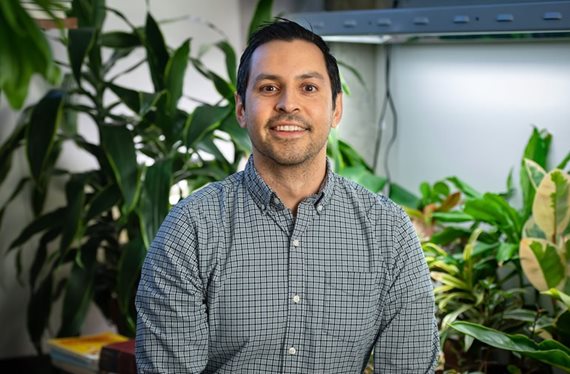
Recycling has limits. Take arsenic, for example. After the Industrial Revolution, it appeared that the byproduct of copper smelting could be readily recycled as a pesticide for farming. Turning a toxic leftover into a commodity seemed like a win-win for the mining industry and agriculture.
It was not, said Adam Romero, an assistant professor in UW Bothell’s School of Interdisciplinary Arts & Sciences. Rather, a problem isolated at smelters turned into a pervasive poison.
“We took a waste product and spread it across the entire United States,” Romero said.
Engaging the community
Romero researches and teaches about the history of agrochemicals, such as arsenic, and the political and economic influences on food production. Some courses include The Industrial Animal, and Food and the Environment. Romero is also now writing a book, “Economic Poisoning: Industrial Waste and the Chemicalization of United States Agriculture.”
He will share some of his research in a free, public lecture, “Arsenic and Old Waste,” Feb. 26. It is the latest in a series of Pub Night Talks featuring UW Bothell faculty and other community experts speaking at McMenamins Anderson School in downtown Bothell. Talking about “poison agriculture,” he said, is a vehicle to think about the industry in a more complex and nuanced way.
Romero also enjoys meeting the public and answering questions as a volunteer in the King County Master Gardener program. A gift for greenery is evident in his UW Bothell office where potted plants vie for space with books.
Challenging justifications
Romero challenges whether it was even necessary for arsenic to become the basis for many pesticides in the period before World War II. The main justification for its use was the fear of hunger. But surplus was often a bigger problem for agriculture than scarcity, Romero said, and farming methods and practices were significant factors.
“We can’t justify pesticides by saying we’re going to run out of food. We continue to have global food gluts. People don’t eat not because there isn’t enough food,” Romero said, “but because they’re poor.”
One of the crops that used the most pesticides in the United States was not a sustenance crop. It was cotton. The extensive use of pesticides, he said, also coincided with monocropping, the practice of planting the same variety year in and year out on the same land.
How about apples
Consider Washington’s famous apple crop. Orchards were some of the largest users of arsenic-based pesticides until synthetic products such as DDT were introduced after World War II, Romero said. Most apples were grown for export rather than local consumption.
Long after the apples went to the global market, soils in some orchards and farms retained high levels of arsenic, Romero said.
“It’s still around. Mothers and fathers today are concerned about arsenic in rice, in baby formula, in apple juice. It’s in wine,” Romero said. “Some of it comes from the environment, but a lot of it we put there.”
Arsenic-based pesticides and herbicides were used extensively through the early 1990s, Romero said. Locally, the Asarco smelter in Tacoma processed arsenic that went into pesticides and wood preservatives. After operating nearly 100 years, the smelter was forced to close in 1985.
Thus, the history of agrochemicals is also “the history of pollution regulation and citizens pushing back against destruction from corporations,” Romero said.
Connecting learning
Today, the same corporations that process most food have institutionalized organics. Romero is concerned for small farmers trying to produce alternate foods.
“How can we create programs and institutions that allow some of these young growers to get their own land?”
There are many challenges, Romero said. “Rethinking the food system is more than rethinking how we grow food. It’s rethinking the institutions.”



